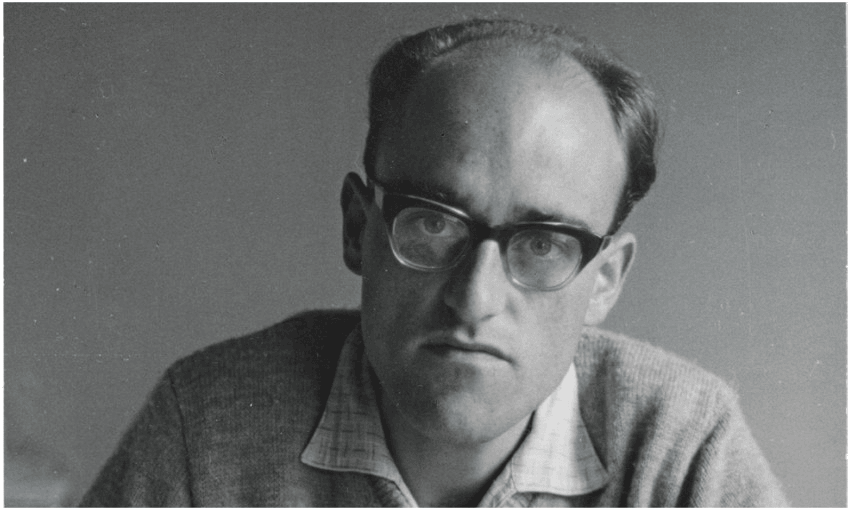Jordan Margetts, who is working on a masters comparing CK Stead and Philip Roth, reviews the second volume of Stead’s memoir.
Not least among the neuroses and quiddities of novelists and poets is the lingering idea that they might actually get to cheat death. Not the death of the body, of course, but there’s a conviction that if the talent is strong enough, and chance is kind enough, then the words, if they’re good enough, will live on. Books, though, are written for their contemporary readers, or at least their authors. What works now may not work later, and nobody is much good at guessing – how many sensations have we already forgotten? White Teeth, anyone? The Luminaries, anyone? With the relatively new phenomenon of the senescent author – our elders live so very long now – we see the mind turn both to the grave and to the past, while the work starts taking aim at the future.
You Have a Lot to Lose pitches itself not only to the reader of the moment, but to the readers and scholars of the future. You can’t help but feel sorry for any potential future biographers. Stead’s mammoth three-volume memoirs are surely among the longest in New Zealand letters. They seem determined to cover and clarify, and get as close as possible to the last word on, virtually every possible piece of biographical detail. This memoir is an act of writerly and scholarly will: replete with quotations, score settling and, inevitably, plenty of name dropping. Stead is attempting to control the biographical narrative – and look, he’s already succeeded. It seems every review of the book so far has focused on the opening claim that he’s “a truthful recorder”.
The memoir is chronological and systematic. Stead talks about his tidy office and his tidy mind, and this is on abundant display here. In this sense it’s a pretty old-fashioned kind of book. Stead entirely ignores the influence of the novelistic memoir, works of prose art in and of themselves. Think of Amis’s Experience, Updike’s Self Consciousness; books unconcerned with coverage that operate around and dramatise some central motif or preoccupation (death, fatherhood, and mid-life crises in the case of Amis; skincare, stuttering, and Vietnam in the case of Updike). Stead’s is firmly in the old-man-remembers school of memoir writing. He starts at one important juncture and works his way to another: beginning with his departure from New Zealand for a lectureship in Armidale, and ending with his departure from an Auckland University professorship to become a “full time” New Zealand writer.
Across his literary journalism and fiction, Stead’s prose is characterised by bone-clean, grammatically simple, often declarative sentences. His great strength is the longer – usually geographical – descriptive passage. When his novels really work – The Death of The Body, or The End of The Century at The End of the World – we get whole works that are effectively geographies of mind, or of self. Take Stead’s early descriptions of Australia:
It was with Otto [Bergman] that we first saw Brisbane, with its suburban houses on stilts, and Queensland’s Gold Coast, then only a glorious strip of untenanted sand with a few low-rise buildings, and no hint of the real-estate dream (and nightmare) it has since become. Of that northern region in general I still have strong but rather unspecific memories of flame trees, poinsettias, bananas, pineapples, sugar cane – and the heat – and still brown water that might have hidden crocodiles.
The country we were seeing by car seemed to run on and on, its bush lacking the density and greenness of New Zealand’s rainforest, but loping and sprawling and grey-blue forever into distance, as if leisure, even in the patterns of local speech, came naturally because hurry was pointless: this was a continent not an island, and no one was going anywhere fast or getting anywhere soon. Furthermore (and further yet) somewhere in there, over there, away “back of beyond” and out of sight, you knew was the red desert and the bones of its hapless mapmakers.
Lines like these have the ability to sneak up on you. There’s something humble in the way Stead refuses to dress up the language. The effect builds through the accretion of simply stated images. Each one alone is unadorned and unimpressive, but together they create an environment that can breathe. It’s the kind of language that selects reality, makes it beautiful, makes it seen.
What follows from Armidale is effectively a long success story: a PhD at Bristol and then a lectureship at Auckland, literary prizes, publications, and a few controversies for good measure. A life shifting between the Southern hemisphere and the Northern: the Menton fellowship, an early professorship, and eventually early retirement. The book moves along at a jaunty clip, despite its relative length and Stead’s typically systematic, vaguely scholarly organisational structure. There’s something scholarly too in the leaning on quotations throughout – from journals and letters, his poems and writings, even reviews of his own work.
Along with the story of a sparkling career, for the most part we get two threads running through the book: Stead’s thinking about literature and especially poetry (this stuff is a real treat, fantastic little essayettes on Auden, Plath, and Yeats), and Stead’s political life. The memoir includes a thumping good rendition of the Springbok tour, as well as a life dedicated to the writing of books; not only their creation and inspiration, but also their reception. This is where Stead gets into trouble. He has a predilection for quoting reviews of his own work, sometimes at great length, and declaring the work a success – as if he’s settled it. From the minute the New Poetic is published we are told that the Guardian declared the book brilliant. We’re told about the “many positive reviews” of All Visitors Ashore, and given a lengthy quotation to help make the point. The same goes for Stead’s third novel The Death of the Body, on which he sums up his own thoughts: “having at this date (December 2018) re-read it, The Death of the Body still strikes me as exceptionally clever and entertaining.”
I don’t have space to quote every example of Stead lauding his own work nor, even worse, reporting on and quoting contemporary praise. Thankfully it takes up only a fairly small portion of the memoir, though he does it virtually every time he talks about a published volume. The tone at such times is spiky and defensive, argumentative and, importantly, humourless. Stead can be very funny, especially in his poems. But on the topic of himself as a writer he’s austerely serious to the point of embarrassment. It makes for bad reading, it’s awkward, and it’s boring. It jolts the reader away from the story; it seems so concerned with setting the record straight, telling us how the books should be thought of (he seldom quotes negative reviews, and when he does, declares them wrong). These asides end up as roadblocks that bring to a screeching halt this otherwise lively and sophisticated affair. I started to wonder if Stead, with his penchant for titles like Book Self and Shelf Life, should have called this one Shelf Satisfied.
The day in Paris was cold, there was ice on the puddles and clouds in the sky, and one of my great travel moments, the kind that stays with you for ever, was waking in our compartment (a couchette this time, fold-down beds, rather than the flash wagon lit of the previous night) to the sight of the blue of the Mediterranean, the yellow walls and orange roofs of its houses, the scarlet and purple bougainvillea and yellow mimosa, the hill-slopes of vines and olives and citrus – those classical landscapes which seemed, and can still seem (and perhaps not only to the Eurocentric mind) the real centre of the civilised world. It was Dr Johnson’s stone again. Beauty existed; it was not just an idea, or a subjective and personal preference, but a human fact, an aspect of “reality”. What I was seeing at that moment was beautiful. Whatever lay ahead in my life (and a significant part of it would have connections here) this shock of excitement marked a moment.
It seems to me that Stead’s patrician hauteur, and his blunt public persona, hide what actually explains and ties all this together – the good and the bad, the brilliant and the bloviating – which is excitement. It’s true and it’s fascinating. What reads as tedious arrogance (and it is tedious) is, I think, actually a feature of the same man who enthusiastically holds hands with his mistress in the Domain, and engages in eye wateringly goofy numerology games, who loves the flowers of the Mediterranean, the eucalypts of Australia, the warm wet climate of Auckland, and who is driven nearly to hysterics by his first experience with Wagner – all subjects of fascination, all real, all worth recording. In a way there’s something sweet about it. Stead isn’t even pretending to be cool, he really cares about this.
Is there some degree of literary anxiety here? Of course. Stead knows that only time will tell, he says so himself, but you get the sense he’d prefer to tell time. This is a book about the past angling at the future, but it’s also bursting with a kind of infectious passion for art and life – and if that slides into anxiety about his place in the pantheon, it’s perhaps the fault of reviewers failing to see that all the bluster is really a feature of an enthusiast rather than a snob. This anxiety about status has shown up before – not least in Stead’s tendency to reply to reviews of his works. Often, as in his response to the Landfall review of The Necessary Angel that accused him of writing a fairly unbelievable female character, his defence is “but it’s based on a real person”. You see this tendency, this focus on veracity, in Stead’s recollection of a discussion with AS Byatt about a character’s dying thoughts in her novel Still Life. Stead’s concern that they aren’t believable is solved by the author telling him it was based on a real experience. Conversely, in a couple of very snarky (and fun) attacks on the critic Frank Kermode, Stead presents Kermode’s admission of dishonesty as the knockout punch – the great vice. This is Stead’s fundamental impulse. In philosophical debate Samuel Johnson’s stone is the ultimate pragmatist’s answer to the notion that our relationship to the outside world is governed entirely by perception, that everything is dependent on how we see it. Johnson was incensed at the idea that we can’t claim to really know the outside world is there. It isn’t only perception: watch me kick this stone, if I kick the stone and my foot bounces off it, or the stone moves, then clearly the outside world is there. It’s obvious, you can see it (Stead perhaps doesn’t know that Johnson’s stone is universally regarded as a fallacy in philosophy classes, but no matter). And if Stead’s truth is idiosyncratic and strident, perception dressed as truth, would we really have it any other way?
You Have a Lot to Lose is a very erudite recounting of one part of a long and important literary life. In part it’s a story of standing upright here, and like Curnow’s moa Stead is peculiarly New Zealand’s – even if the crutches were found in large part overseas. If the book has certain faults in tone and texture, that’s all part of the fun too. Ultimately Stead needn’t worry about his legacy. The work speaks for itself, even when he tries to speak over it.
You Have a Lot to Lose: A Memoir 1956-1986, by CK Stead (Auckland University Press, $49.99), is available from Unity Books Auckland and Wellington.



